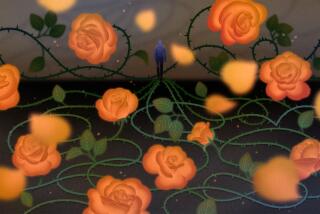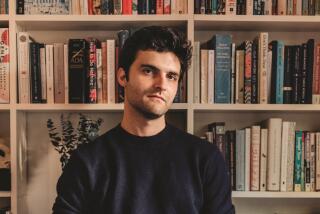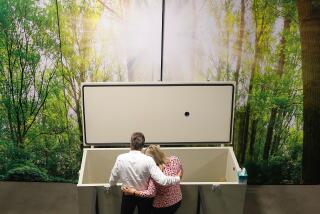She’s Scouting a More Humane Path for Her Dying Patients
- Share via
Debbie Sutterfield believes there is something wrong with the way people are dying.
Too often, she has seen terminally ill patients shuttled between home and hospital emergency rooms, with no one willing to acknowledge their difficult journey toward death. Dying patients can fall into a kind of limbo, she said, enveloped by a denial of death on the part of their caregivers that leaves them feeling abandoned and their families feeling helpless.
“It was so sad. We put them through so much just trying to get them better, knowing it really wasn’t going to help,” Sutterfield said of her experience as a critical care nurse.
“When they went home, whatever their environment was out there, it wasn’t working. Their families usually didn’t know anything about medicine. Sometimes they would come back to the emergency room in such pain. They’d be nauseous, they’d be vomiting, they’d have diarrhea; they just couldn’t control the symptoms. If they had somebody on the outside who could call their doctor . . . they wouldn’t have had to come back.”
The 34-year-old Newport Beach resident left critical care nursing 14 months ago and now oversees hospice care for about 15 terminally ill patients at a time. While most want to live as long as they can, some ask her to help them die.
“Every now and then, I’ll get a patient who asks me to do that for them. I’ll have them on a morphine pump and they’ll say, ‘Can’t you just turn it up and let me go? Can’t you just give me something? Can’t you just give me a pill?’ And I tell them that’s not legal, and I have to live with myself after they’re gone. They’ll turn to their families and I tell them the same thing.”
*
With public opinion polls showing increasing support for physician-assisted suicide, Sutterfield says hospice is a more humane way to deal with death and should be part of the national debate.
“You’d want to die if you were throwing up all the time or you had pain that was just unbearable. I can imagine somebody feeling like that. . . .
“I don’t know if assisted suicide is the wave of the future, but once you get their symptoms managed, most of my patients don’t want to die. Then they want to continue with the quality of life they have, as long as they can.”
Sutterfield, a registered nurse, worked at Hoag Memorial Hospital Presbyterian in Newport Beach for six years before joining Hospice Family Care in Tustin. She was not aware that hospice existed until about two years ago, when her husband’s uncle learned he had lung cancer.
“They had hospice, and all throughout his disease they told us how it was going. They had people coming in and helping them a lot. They got him on the right medications. At the end of it, the family came out of it so well. As odd as it sounds, it was a pleasant experience for them.”
It was more than regular home nursing could accomplish.
“In hospice, we focus on the last stages of life and making our patients more comfortable. Our biggest thing that we do is pain control, because a lot of our patients have cancer. We know a little more about pain medicine, how it’s given and how it works, than a home health nurse. They don’t deal with severe pain and continually increasing pain on an ongoing basis. So if they can’t handle it, the patient ends up going back to the hospital. We don’t do that.”
*
Sutterfield works with a team that includes a supervising physician, home health-care nurses, social workers, counselors and chaplains. Much of their work is with the families of patients whose life expectancies range from a few weeks to six months.
“When you have a terminal disease, you can have a lot of family dynamics going on. In one of my families, the son hasn’t spoken to his father in 15 years. I think the father is holding on because he wants to say goodbye to his son, but his son won’t talk to him. So we’ve got a counselor involved with them.”
Despite the rigors of being on 24-hour call and routinely keeping in touch with patients from home, Sutterfield views her work as an improvement over her previous career. As a critical care nurse, she was continually troubled by the way people died.
“Once they got to our unit, they were usually pretty sick and they often didn’t make it. That bothered me because a lot of times they were alone. That’s everybody’s biggest fear, to die alone. All of our patients were on a heart monitor, so whenever we saw somebody going, I’d race into the room and talk to them. I’d sit there and tell them, ‘It’s OK. I’m with you.’ ”
Now, most of her patients are with their families during their final days.
“I treat people the way I would want to be treated. I would want to be in my own home and be pain-free as best as I could, and I would want my family cared for. I’ve never been happier in my life, because I can make the worst time in their lives and in their families’ lives better.
“We’re all dying. It’s a natural part of life. But I try to pull them out of focusing on death, so they can enjoy the quality of life they have left.”
(BEGIN TEXT OF INFOBOX / INFOGRAPHIC)
Profile: Debbie Sutterfield
Age: 34
Hometown: Laguna Beach
Residence: Newport Beach
Family: Married, with two preschool-age children
Education: Associate of arts degree in nursing from Rancho Santiago College; graduate training by the Assn. for Critical Care Nursing
Background: Nurse’s aide for four years before becoming a registered nurse; worked at Hoag Memorial Hospital Presbyterian in Newport Beach as a floor nurse for four years and critical care nurse for two years
Current position: Primary registered nurse for Hospice Family Care Inc. in Tustin
Sharing last days: “So many people are so sweet. I do a lot of crying. One lady I got to know had lung cancer. She was on the program for a long time. She said I was her ‘rainbow’ every time I’d come to visit. She said that she wanted my children to live long, happy and healthy lives. Oh God, I really lost it then.”
Source: Debbie Sutterfield; Researched by RUSS LOAR / For The Times
More to Read
Sign up for Essential California
The most important California stories and recommendations in your inbox every morning.
You may occasionally receive promotional content from the Los Angeles Times.










